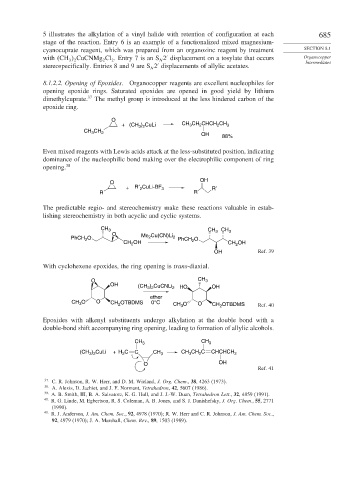Page 709 - Advanced Organic Chemistry Part B - Reactions & Synthesis
P. 709
5 illustrates the alkylation of a vinyl halide with retention of configuration at each 685
stage of the reaction. Entry 6 is an example of a functionalized mixed magnesium-
cyanocuprate reagent, which was prepared from an organozinc reagent by treatment SECTION 8.1
with CH CuCNMg Cl . Entry 7 is an S 2 displacement on a tosylate that occurs Organocopper
2
3 2
N
2
Intermediates
stereospecifically. Entries 8 and 9 are S 2 displacements of allylic acetates.
N
8.1.2.2. Opening of Epoxides. Organocopper reagents are excellent nucleophiles for
opening epoxide rings. Saturated epoxides are opened in good yield by lithium
dimethylcuprate. 37 The methyl group is introduced at the less hindered carbon of the
epoxide ring.
O
+ (CH 3 ) 2 CuLi CH CH CHCH CH 3
2
2
3
CH CH 2 OH 88%
3
Even mixed reagents with Lewis acids attack at the less-substituted position, indicating
dominance of the nucleophilic bond making over the electrophilic component of ring
opening. 38
O OH
+ R′ CuLi-BF 3 R′
2
R R
The predictable regio- and stereochemistry make these reactions valuable in estab-
lishing stereochemistry in both acyclic and cyclic systems.
CH 3 CH 3 CH
O Cu(CN)Li 3
PhCH 2 O Me 2 2 PhCH O
OH 2
CH 2 CH 2 OH
OH Ref. 39
With cyclohexene epoxides, the ring opening is trans-diaxial.
O CH 3
OH
) CuCNLi
(CH 3 2 2 HO OH
ether
CH 3 O O CH OTBDMS 0°C CH 3 O O CH OTBDMS Ref. 40
2
2
Epoxides with alkenyl substituents undergo alkylation at the double bond with a
double-bond shift accompanying ring opening, leading to formation of allylic alcohols.
CH
CH 3 3
(CH ) CuLi + H C C CH 3 CH 3 CH C CHCHCH 3
2
2
3 2
O OH
Ref. 41
37 C. R. Johnson, R. W. Herr, and D. M. Wieland, J. Org. Chem., 38, 4263 (1973).
38 A. Alexis, D. Jachiet, and J. F. Normant, Tetrahedron, 42, 5607 (1986).
39
A. B. Smith, III, B. A. Salvatore, K. G. Hull, and J. J.-W. Duan, Tetrahedron Lett., 32, 4859 (1991).
40 R. G. Linde, M. Egbertson, R. S. Coleman, A. B. Jones, and S. J. Danishefsky, J. Org. Chem., 55, 2771
(1990).
41
R. J. Anderson, J. Am. Chem. Soc., 92, 4978 (1970); R. W. Herr and C. R. Johnson, J. Am. Chem. Soc.,
92, 4979 (1970); J. A. Marshall, Chem. Rev., 89, 1503 (1989).

